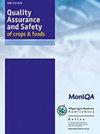干柿子果实中的真菌菌群
IF 5.3
3区 农林科学
Q1 FOOD SCIENCE & TECHNOLOGY
引用次数: 4
摘要
柿子由于保质期短,通常在当季新鲜食用,但也可以作为干果食用。近年来,当地小型企业销售的柿干整体发霉。本研究对整个柿子干的果实表面和内部的真菌分布进行了研究。采用含40%蔗糖的酸化马铃薯葡萄糖琼脂和麦芽提取物琼脂分别测定霉菌和酵母计数和亲渗计数。根据其培养和形态特性对霉菌分离物进行鉴定。采用两种不同的取样方法,除亲渗霉菌计数外,未发现亲渗酵母计数、酵母计数和霉菌计数有显著差异。本研究发现,95%的样品被霉菌污染,霉菌数量在< 1-4.34 log菌落形成单位/克(cfu/g)范围内。从柿子干中分离出17种不同的霉菌属,主要菌群为根霉属、青霉属和曲霉属。本文章由计算机程序翻译,如有差异,请以英文原文为准。
Fungal microflora in dried persimmon fruits
Persimmon fruit due to its short shelf life is often consumed as fresh during the season, but it is also consumed as a dried fruit. In recent years, dried persimmon fruits with mouldy appearance as a whole are sold by small-scale local enterprises. In this study, the fungal profile of both fruit surface and inner parts of the whole dried persimmon fruit was investigated. Mould and yeast counts and osmophilic count were determined by using acidified potato dextrose agar and malt extract agar containing 40% sucrose respectively. Mould isolates were identified considering their cultural and morphological properties. Two different sampling methods were applied and no significant differences were found for osmophilic yeast counts, yeast counts and mould counts except osmophilic mould counts. In this study, it was observed that 95% of the samples were contaminated with moulds and the number of moulds was in the range of <1–4.34 log colony forming units per gram (cfu/g). Seventeen different genera of moulds were isolated from dried persimmon fruits, and the dominant microflora of the analysed samples were Rhizopus spp., Penicillium spp. and Aspergillus spp.
求助全文
通过发布文献求助,成功后即可免费获取论文全文。
去求助
来源期刊

Quality Assurance and Safety of Crops & Foods
FOOD SCIENCE & TECHNOLOGY-
CiteScore
4.60
自引率
7.50%
发文量
61
审稿时长
1 months
期刊介绍:
''Quality Assurance and Safety of Crops & Foods'' is an international peer-reviewed journal publishing research and review papers associated with the quality and safety of food and food sources including cereals, grains, oilseeds, fruits, root crops and animal sources. It targets both primary materials and their conversion to human foods. There is a strong focus on the development and application of new analytical tools and their potential for quality assessment, assurance, control and safety. The scope includes issues of risk assessment, traceability, authenticity, food security and socio-economic impacts. Manuscripts presenting novel data and information that are likely to significantly contribute to scientific knowledge in areas of food quality and safety will be considered.
''Quality Assurance and Safety of Crops & Foods'' provides a forum for all those working in the specialist field of food quality and safety to report on the progress and outcomes of their research.
 求助内容:
求助内容: 应助结果提醒方式:
应助结果提醒方式:


